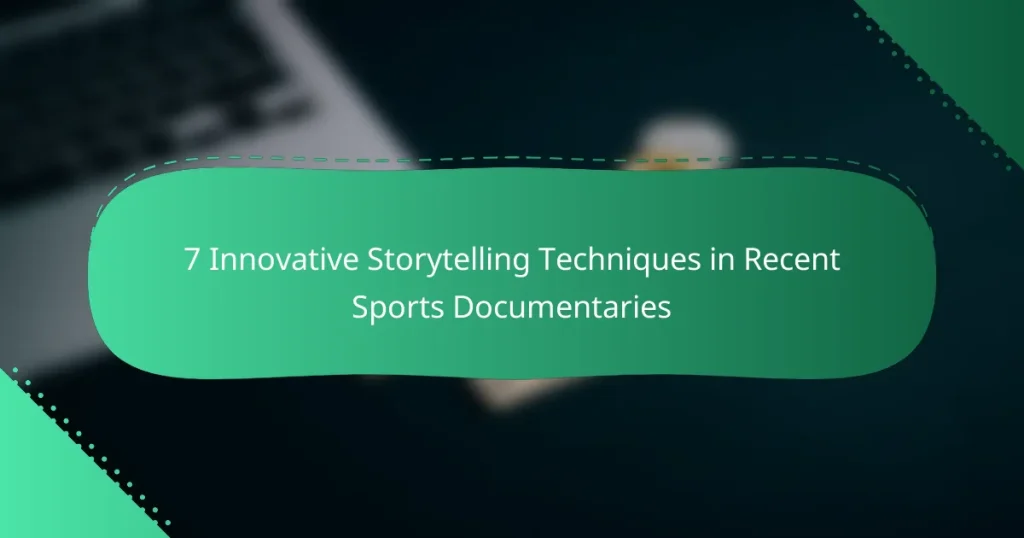In recent years, sports documentaries have embraced innovative storytelling techniques that captivate audiences and redefine how athletic narratives are presented. By employing methods such as non-linear narratives, character-driven stories, and immersive visuals, filmmakers create engaging experiences that resonate on a personal level. These techniques not only enhance viewer engagement but also offer fresh perspectives on familiar sports stories.

What Are the Most Innovative Storytelling Techniques in Sports Documentaries?
Innovative storytelling techniques in sports documentaries enhance viewer engagement and provide fresh perspectives on familiar narratives. These methods include non-linear narratives, character-driven stories, immersive visuals, interactive elements, and real-time storytelling, each offering unique ways to connect with audiences.
Non-linear Narratives
Non-linear narratives disrupt traditional chronological storytelling by presenting events out of order. This technique allows filmmakers to create suspense and intrigue, encouraging viewers to piece together the story themselves. For example, a documentary might start with a climactic moment before flashing back to earlier events that led to it.
When using non-linear narratives, consider how to maintain clarity. Ensure that transitions between timelines are smooth and that viewers can easily follow the story’s progression. This approach can deepen emotional impact and keep audiences engaged.
Character-Driven Stories
Character-driven stories focus on the personal journeys of athletes, coaches, or fans, providing a deeper emotional connection. By highlighting individual struggles, triumphs, and motivations, these documentaries create relatable narratives that resonate with viewers. A well-known example is the portrayal of an athlete’s comeback from injury, showcasing their determination and resilience.
To effectively implement this technique, prioritize character development and authenticity. Use interviews, personal anecdotes, and behind-the-scenes footage to build a compelling narrative that draws viewers into the character’s world.
Immersive Visuals
Immersive visuals enhance storytelling by using high-quality cinematography, drone footage, and innovative editing techniques. These visuals can transport viewers into the heart of the action, making them feel as if they are part of the experience. For instance, slow-motion shots during critical moments can heighten tension and drama.
When creating immersive visuals, invest in quality equipment and consider the emotional tone of each scene. Use visuals to complement the narrative rather than overshadow it, ensuring that they serve the story’s purpose.
Interactive Elements
Interactive elements allow viewers to engage with the documentary in real-time, often through digital platforms. This can include choosing different story paths, accessing additional content, or participating in live discussions. Such features can enhance viewer investment and create a community around the documentary.
To effectively incorporate interactive elements, ensure they are user-friendly and enhance the viewing experience. Consider platforms that support interactivity and gather feedback to refine these features for future projects.
Real-time Storytelling
Real-time storytelling captures events as they unfold, providing an immediate and authentic experience. This technique is often used in live sports coverage but can also be applied in documentaries to convey the urgency of a situation, such as a championship game or a critical moment in an athlete’s career.
When employing real-time storytelling, focus on pacing and the ability to convey emotion in the moment. Use social media and live updates to engage audiences and keep them informed, creating a sense of immediacy that enhances the narrative’s impact.

How Do Non-linear Narratives Enhance Storytelling?
Non-linear narratives enhance storytelling by allowing filmmakers to present events out of chronological order, creating intrigue and emotional depth. This technique engages viewers by revealing key moments at strategic points, encouraging them to piece together the story themselves.
Engagement Through Suspense
Non-linear storytelling builds suspense by delaying critical information, which keeps audiences on the edge of their seats. For instance, a documentary might start with a climactic event and then backtrack to explore the events leading up to it, creating a sense of urgency and anticipation.
To effectively use suspense, filmmakers should carefully select which moments to reveal early and which to hold back. This can involve cliffhangers or unexpected twists that challenge viewers’ assumptions, making the narrative more compelling.
Multiple Perspectives
Incorporating multiple perspectives in a non-linear narrative allows for a richer, more nuanced understanding of the story. By presenting different viewpoints, filmmakers can highlight contrasting experiences and emotions, which adds depth to the narrative.
For example, a sports documentary might feature interviews with players, coaches, and fans, each offering unique insights into a pivotal game. This approach not only broadens the audience’s perspective but also fosters empathy and connection with the subjects.

What Role Do Character-Driven Stories Play?
Character-driven stories are essential in sports documentaries as they create a personal connection between the audience and the athletes. These narratives highlight individual journeys, struggles, and triumphs, making the sports experience relatable and engaging.
Emotional Connection
Emotional connection is crucial in storytelling, particularly in sports documentaries. By showcasing the highs and lows of athletes’ lives, filmmakers can evoke feelings of empathy and inspiration in viewers. This connection often leads to a deeper investment in the athletes’ journeys, making their victories feel more significant.
For instance, a documentary that follows an athlete overcoming personal challenges, such as injury or family issues, can resonate with audiences who have faced similar struggles. This shared experience fosters a bond that enhances viewer engagement and loyalty to the sport.
Relatable Heroes
Relatable heroes are central to effective storytelling in sports documentaries. When athletes are portrayed as real people with flaws and aspirations, they become more accessible to the audience. This relatability allows viewers to see themselves in the athletes’ stories, making their achievements feel attainable.
Documentaries that highlight the everyday lives of athletes, including their routines, challenges, and personal relationships, can create a sense of camaraderie. For example, showcasing an athlete’s dedication to training while balancing family life can inspire viewers to pursue their own goals, regardless of their circumstances.

How Are Immersive Visuals Used in Documentaries?
Immersive visuals in documentaries enhance storytelling by creating a more engaging and realistic experience for viewers. Techniques like high-definition footage and 360-degree views allow audiences to feel as if they are part of the action, deepening their connection to the subject matter.
High-Definition Footage
High-definition footage captures images with exceptional clarity and detail, making scenes more vivid and impactful. This technique is particularly effective in sports documentaries, where the intensity of the action can be fully appreciated through sharp visuals.
Using high-definition cameras can significantly elevate the viewer’s experience, especially during key moments like game-winning plays or emotional athlete interviews. Filmmakers should consider the equipment’s resolution and frame rate to ensure the best quality, typically aiming for at least 1080p resolution.
360-Degree Views
360-degree views provide a panoramic perspective, allowing viewers to explore the environment around the action. This technique is often used in virtual reality experiences, where audiences can look in any direction, immersing them in the setting of the documentary.
In sports documentaries, 360-degree views can showcase stadiums, training facilities, and behind-the-scenes moments that traditional filming methods might miss. Filmmakers should ensure that the audio and visual quality remains high, as poor execution can detract from the immersive experience.

What Are Interactive Elements in Sports Documentaries?
Interactive elements in sports documentaries engage viewers by allowing them to influence the narrative or explore content in a personalized manner. These features enhance the storytelling experience, making it more immersive and participatory.
Viewer Participation
Viewer participation involves allowing audiences to make choices that affect the documentary’s direction or content. This can include selecting different storylines, accessing additional footage, or participating in polls during the viewing experience. Such engagement can deepen emotional connections and increase viewer investment in the story.
For example, a documentary on a famous athlete might let viewers choose which game highlights to watch or provide insights into behind-the-scenes moments. This not only enriches the experience but also encourages discussions among viewers, enhancing community engagement.
Augmented Reality Features
Augmented reality (AR) features in sports documentaries overlay digital information onto the real world, enhancing the storytelling with interactive visuals. Viewers can use their smartphones or AR glasses to see statistics, player bios, or historical data while watching the documentary, creating a richer context.
For instance, an AR feature might allow viewers to visualize a player’s stats in real-time during a critical game moment, making the experience more informative. However, it’s essential to ensure that these features do not distract from the main narrative; balance is key to maintaining viewer focus.

How Does Real-time Storytelling Impact Viewer Experience?
Real-time storytelling enhances viewer engagement by providing immediate updates and fostering a sense of connection to live events. This technique allows audiences to experience the unfolding narrative as it happens, creating a more immersive viewing experience.
Timely Updates
Timely updates in sports documentaries keep viewers informed about ongoing events, player performances, and critical moments. This approach can include live scores, injury reports, and game-changing plays, which help maintain audience interest and excitement. For instance, during a championship game, real-time statistics can be displayed to highlight player achievements and team strategies.
To effectively implement timely updates, consider using social media feeds or dedicated graphics that provide instant information. This not only enriches the storytelling but also encourages viewers to engage with the content on multiple platforms.
Live Audience Reactions
Incorporating live audience reactions into sports documentaries adds an emotional layer to the storytelling. Viewers can witness the immediate responses of fans, players, and commentators, which amplifies the drama of key moments. For example, capturing the crowd’s roar during a last-minute goal can significantly enhance the narrative impact.
To leverage live audience reactions, filmmakers can use split-screen techniques or integrate social media comments in real-time. This method fosters a community feeling among viewers, making them feel part of the event, rather than just passive observers.

What Are the Criteria for Selecting Effective Storytelling Techniques?
Effective storytelling techniques in sports documentaries are chosen based on their ability to engage audiences, convey emotions, and present compelling narratives. Key criteria include originality, emotional resonance, clarity of message, and the ability to connect with the audience’s experiences or aspirations.
1. Non-linear Narratives
Non-linear narratives break away from traditional chronological storytelling, allowing filmmakers to weave together different time periods and perspectives. This technique can create suspense and intrigue, drawing viewers into the story by revealing key moments out of sequence.
For example, a documentary about a famous athlete might start with their retirement, then flash back to pivotal moments in their career. This approach keeps the audience engaged and encourages them to piece together the narrative themselves.
2. Immersive Visuals
Immersive visuals enhance storytelling by using high-quality footage, animations, and graphics to create a vivid experience. This technique can transport viewers into the world of the athletes, making them feel as if they are part of the action.
Documentaries often utilize drone shots, slow-motion sequences, and close-ups to highlight the intensity of sports moments. Such visuals can evoke strong emotions and deepen the audience’s connection to the story.
3. Personal Interviews
Personal interviews with athletes, coaches, and family members provide intimate insights into the subjects’ lives and motivations. This technique humanizes the story and allows viewers to understand the personal struggles and triumphs behind the public persona.
Incorporating candid interviews can reveal vulnerabilities and strengths, making the narrative more relatable. For instance, an athlete discussing their mental health challenges can resonate with viewers facing similar issues.
4. Thematic Focus
A thematic focus helps to unify the documentary’s narrative around a central idea or message. This technique ensures that all elements of the story contribute to a cohesive understanding of the subject matter.
For example, a documentary might explore themes of resilience and determination through various athletes’ stories, illustrating how these qualities manifest in different contexts. This approach can inspire and motivate audiences by highlighting universal values.
5. Use of Archival Footage
Incorporating archival footage adds depth and authenticity to sports documentaries. This technique allows filmmakers to connect past events with present narratives, providing context and background for the audience.
Using historical clips can evoke nostalgia and highlight the evolution of sports over time. For instance, showing footage from a legendary game can enhance the storytelling by linking it to current athletes’ experiences.
6. Sound Design and Music
Sound design and music play crucial roles in shaping the emotional landscape of a documentary. Effective use of sound can amplify tension, excitement, or poignancy, enhancing the overall viewing experience.
For example, a powerful score during a climactic moment can elevate the drama, while ambient sounds can immerse viewers in the atmosphere of a sporting event. Selecting the right music and sound effects is essential for creating an impactful narrative.
7. Audience Engagement Techniques
Engaging the audience through interactive elements or social media can enhance the storytelling experience. Techniques such as polls, Q&A sessions, or behind-the-scenes content can foster a sense of community and connection.
For instance, encouraging viewers to share their own sports stories or reactions on social media can create a dialogue around the documentary. This engagement can deepen the audience’s investment in the narrative and its themes.

